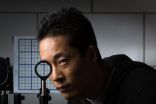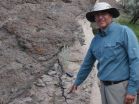(Press-News.org) Inspired perhaps by Harry Potter's invisibility cloak, scientists have recently developed several ways--some simple and some involving new technologies--to hide objects from view. The latest effort, developed at the University of Rochester, not only overcomes some of the limitations of previous devices, but it uses inexpensive, readily available materials in a novel configuration.
"There've been many high tech approaches to cloaking and the basic idea behind these is to take light and have it pass around something as if it isn't there, often using high-tech or exotic materials," said John Howell, a professor of physics at the University of Rochester. Forgoing the specialized components, Howell and graduate student Joseph Choi developed a combination of four standard lenses that keeps the object hidden as the viewer moves up to several degrees away from the optimal viewing position.
"This is the first device that we know of that can do three-dimensional, continuously multidirectional cloaking, which works for transmitting rays in the visible spectrum," said Choi, a Ph.D. student at Rochester's Institute of Optics.
The details of the device are now published in the journal Optics Express.
Many cloaking designs work fine when you look at an object straight on, but if you move your viewpoint even a little, the object becomes visible, explains Howell. Choi added that previous cloaking devices can also cause the background to shift drastically, making it obvious that the cloaking device is present.
In order to both cloak an object and leave the background undisturbed, the researchers determined the lens type and power needed, as well as the precise distance to separate the four lenses. To test their device, they placed the cloaked object in front of a grid background. As they looked through the lenses and changed their viewing angle by moving from side to side, the grid shifted accordingly as if the cloaking device was not there. There was no discontinuity in the grid lines behind the cloaked object, compared to the background, and the grid sizes (magnification) matched.
The Rochester Cloak can be scaled up as large as the size of the lenses, allowing fairly large objects to be cloaked. And, unlike some other devices, it's broadband so it works for the whole visible spectrum of light, rather than only for specific frequencies.
Their simple configuration improves on other cloaking devices, but it's not perfect. "This cloak bends light and sends it through the center of the device, so the on-axis region cannot be blocked or cloaked," said Choi. This means that the cloaked region is shaped like a doughnut. He added that they have slightly more complicated designs that solve the problem. Also, the cloak has edge effects, but these can be reduced when sufficiently large lenses are used.
In their paper, Howell and Choi provide a mathematical formalism for this type of cloaking that can work for angles up to 15 degrees, or more. They use a technique called ABCD matrices that describes how light bends when going through lenses, mirrors, or other optical elements.
While their device is not quite like Harry Potter's invisibility cloak, Howell had some thoughts about potential applications, including using cloaking to effectively let a surgeon "look through his hands to what he is actually operating on," he said. The same principles could be applied to a truck to allow drivers to see through blind spots on their vehicles.
Howell became interested in creating simple cloaking devices with off-the-shelf materials while working on a holiday project with his children. Together with his 14 year-old son and Choi, he recently published a paper about some of the possibilities, and also demonstrated simple cloaking with mirrors, like magicians would use, in a brief video.
INFORMATION:
Paper: Joseph S. Choi and John C. Howell, "Paraxial ray optics cloaking," Opt. Express 22, 29465-29478 (2014) http://www.opticsinfobase.org/oe/abstract.cfm?URI=oe-22-24-29465
Note: A patent has been filed for this cloaking device. Please contact UR Ventures for additional information.
About the University of Rochester
The University of Rochester is one of the nation's leading private universities. Located in Rochester, N.Y., the University gives students exceptional opportunities for interdisciplinary study and close collaboration with faculty through its unique cluster-based curriculum. Its College, School of Arts and Sciences, and Hajim School of Engineering and Applied Sciences are complemented by its Eastman School of Music, Simon School of Business, Warner School of Education, Laboratory for Laser Energetics, School of Medicine and Dentistry, School of Nursing, Eastman Institute for Oral Health, and the Memorial Art Gallery.
Attending to and caring about the emotions of employees and colleagues - that's for wimps, not for tough businesspeople and efficient performers, right? Wrong! An extensive international study has now shown: The "ability to recognize emotions" affects income. The corresponding author of the study is Professor Dr. Gerhard Blickle of the Department of Psychology at the University of Bonn. The results are published in the Journal of Organizational Behavior.
"Although managing employees and dealing with people often involves reading their emotions and determining their moods, ...
A catastrophic landslide, one of the largest known on the surface of the Earth, took place within minutes in southwestern Utah more than 21 million years ago, reports a Kent State University geologist in a paper being to be published in the November issue of the journal Geology.
The Markagunt gravity slide, the size of three Ohio counties, is one of the two largest known continental landslides (larger slides exist on the ocean floors). David Hacker, Ph.D., associate professor of geology at the Trumbull campus, and two colleagues discovered and mapped the scope of the ...
This news release is available in German. Because the skin and its function as a barrier are severely compromised in neurodermatitis patients, a large number of bacterial species are able to multiply - including the bacterium Staphylococcus aureus. Many patients have nearly 200-times as many S. aureus bacteria living on their skin as healthy individuals, resulting in frequent infections. Prof. Tilo Biedermann and his team at the Allergology and Dermatology Clinic of Klinikum rechts der Isar and the University of Tübingen have now shown in an animal model how these ...
A plague of "aquatic osteoporosis" is spreading throughout many North American soft-water lakes due to declining calcium levels in the water and hindering the survival of some organisms, says new research from Queen's University.
Researchers from Queen's, working with colleagues from York University and the University of Cambridge, as well as other collaborators, have identified a biological shift in many temperate, soft-water lakes in response to declining calcium levels after prolonged periods of acid rain and timber harvesting. The reduced calcium availability is hindering ...
Queen's University biologist Virginia Walker and Queen's SARC Awarded Postdoctoral Fellow Pranab Das have shown nanosilver, which is often added to water purification units, can upset your gut. The discovery is important as people are being exposed to nanoparticles every day.
Nanosilver is also used in biomedical applications, toys, sunscreen, cosmetics, clothing and other items.
"We were surprised to see significant upset of the human gut community at the lowest concentration of nanosilver in this study," says Dr. Das. "To our knowledge, this is the first time anyone ...
This news release is available in German. The research team also showed that the pathological changes of the astrocytes can be mitigated by pharmacological treatment. The triggering molecules turned out to be energy carriers of the cell such as ATP: These molecules can induce the astrocytes to switch into a hyperactive state, which is characterized by sudden fluctuations in the concentration of calcium. As the researchers describe in the scientific journal Nature Communications, their study suggests a novel potential approach for the treatment of Alzheimer's disease.
In ...
Residential treatment may be an appropriate first-line option for young adults who are dependent on opioid drugs - including prescription painkillers and heroin - that may result in higher levels of abstinence than does the outpatient treatment that is currently the standard of care. A study from the Massachusetts General Hospital (MGH) Center for Addiction Services found that a month-long, 12-step-based residential program with strong linkage to community-based follow-up care, enabled almost 30 percent of opioid-dependent participants to remain abstinent a year later. ...
Pregnant women with histories of major depression are about 40 percent less likely to relapse into depression if they practice mindfulness techniques--such as meditation, breathing exercises and yoga--along with cognitive therapy, according to a new study led by the University of Colorado Boulder.
About 30 percent of pregnant women who have struggled with depression in the past will again become depressed in the months before and after birth, according to past research. In the new study, published in the journal Archives of Women's Mental Health, the research team found ...
ANN ARBOR, Mich. -- What's the best way to treat rectal cancer? Consult any of five top clinical guidelines for rectal cancer and you will get a different answer, according to a new study by researchers at the University of Michigan Comprehensive Cancer Center.
They looked at clinical practice guidelines for rectal cancer from five highly regarded organizations in the United States, Europe and Canada. The guidelines, which were all published within the last six years, were assessed for overall quality based on how they were developed. The tool used gives a percentage ...
With temperatures dipping, homeowners are firing up their heaters. But systems that require heating oil release fine particles outside that could have harmful health effects. Regulations to curb these emissions in New York City, however, could save hundreds of lives, a new study has found. The report in the ACS journal Environmental Science & Technology may have ramifications for the entire northeast, the country's largest consumer of heating oil.
Iyad Kheirbek and colleagues note that when some people breathe in fine particulate matter from the air, they suffer from ...



